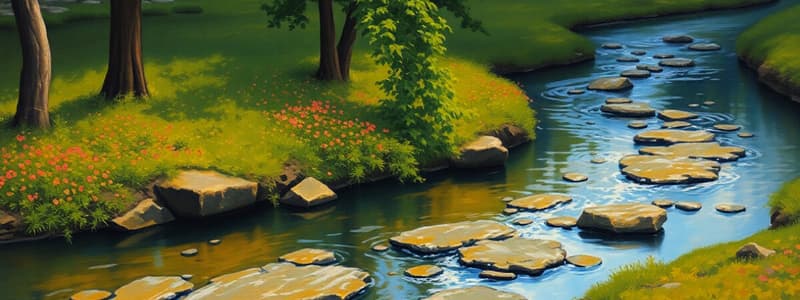Podcast
Questions and Answers
What is the primary characteristic that defines a watershed?
What is the primary characteristic that defines a watershed?
- The volume of water stored in underground aquifers.
- The political boundaries established for water resource management.
- The way land topography directs all water runoff to a shared outlet. (correct)
- The presence of diverse plant life within a specific area.
Watershed boundaries are typically determined by which geographical feature?
Watershed boundaries are typically determined by which geographical feature?
- The highest ridgelines that separate areas of water flow. (correct)
- The lowest elevation points within a land area.
- The boundaries of national parks and protected areas.
- The network of rivers and streams within a region.
Which of the following statements best describes the concept of nested hierarchy in watersheds?
Which of the following statements best describes the concept of nested hierarchy in watersheds?
- Smaller watersheds combine to form progressively larger watersheds, like sub-basins within a drainage basin. (correct)
- The size of a watershed is solely determined by the volume of water it contains.
- Watersheds are strictly organized based on political boundaries for efficient administration.
- Watersheds are independently managed and have no influence on each other.
Which landscape characteristic is LEAST likely to influence water flow within a watershed?
Which landscape characteristic is LEAST likely to influence water flow within a watershed?
What is the relationship between a drainage basin and a watershed?
What is the relationship between a drainage basin and a watershed?
Which factor most significantly increases the speed of water flow in a watershed?
Which factor most significantly increases the speed of water flow in a watershed?
How does vegetation within a watershed contribute to maintaining water quality and supply?
How does vegetation within a watershed contribute to maintaining water quality and supply?
Urban development, characterized by extensive paved surfaces, primarily affects watersheds by:
Urban development, characterized by extensive paved surfaces, primarily affects watersheds by:
What is a defining characteristic of internal drainage basins that leads to high salt concentrations?
What is a defining characteristic of internal drainage basins that leads to high salt concentrations?
Nonpoint source pollution in watersheds is considered particularly challenging to manage primarily because it:
Nonpoint source pollution in watersheds is considered particularly challenging to manage primarily because it:
Flashcards
Watershed
Watershed
An area of land where all water falling on its surface drains to a common outlet, such as a river, lake, or ocean.
Drainage divide
Drainage divide
The highest point of land that separates water flowing into different watersheds.
Nested hierarchy of watersheds
Nested hierarchy of watersheds
Watersheds are organized in a hierarchical structure, with larger basins containing smaller sub-basins.
Landscape and water flow
Landscape and water flow
Signup and view all the flashcards
Drainage basin
Drainage basin
Signup and view all the flashcards
What is a watershed?
What is a watershed?
Signup and view all the flashcards
What is infiltration?
What is infiltration?
Signup and view all the flashcards
What is runoff?
What is runoff?
Signup and view all the flashcards
What is point source pollution?
What is point source pollution?
Signup and view all the flashcards
What is nonpoint source pollution?
What is nonpoint source pollution?
Signup and view all the flashcards
Study Notes
Watershed Definition
- A watershed is a land area that funnels all water falling within its boundaries to a common destination (e.g., river, lake, ocean, wetland).
- Watershed boundaries follow ridgelines, dividing water flow between different watersheds.
- These boundaries are called drainage divides and often do not follow political boundaries.
- Larger watersheds are also called drainage basins, feeding major rivers and other large bodies of water.
Characteristics of Watersheds
- Boundaries: Defined by the highest ridgeline, directing water flow.
- Nested Hierarchy: Watersheds can be large (e.g., Mississippi River basin) or small (e.g., micro-watershed). They are organized in a system of interconnected sub-basins.
- Landscape and Water Flow: Water flow depends on terrain (steeper = faster), soil type, and vegetation cover. Water flow through vegetated areas is slower, allowing for infiltration into the ground.
Facts about Watersheds
- Water Quality and Supply: Watersheds impact streamflow and water quality downstream. Vegetation acts as a filter, cleaning water as it percolates into the ground.
- Flood and Erosion Control: Watershed surfaces (e.g., impervious surfaces in urban areas) greatly influence flood risk. Rapid water flow leads to increased erosion.
- Recreation and Wildlife: Watersheds provide habitat and support a variety of wildlife. Water flow connects ecosystems.
- Human Impacts: Pollution (point and non-point) affects water quality downstream. Clearing vegetation increases flooding, erosion, and reduces water soaking into the ground.
Watershed Examples
- Micro-watershed: Smaller than 2500 acres, providing water for small streams and ponds. Importantly they are vital at a local scale for irrigation and human consumption.
- Internal Drainage Basin: Areas where water flows to a basin with no outlet, leading to water pooling and evaporation or groundwater recharge. Salinization might occur from minerals concentrated as water evaporates.
Human Impacts on Watersheds
- Pollution Sources: Point source pollution (e.g., factories) and non-point source pollution (e.g., runoff from roads) can contaminate watersheds affecting downstream water quality.
- Land Clearing: Removing vegetation increases flooding and erosion, impacting water absorption into the ground.
- Pollution Concentration: Larger bodies of water receive the cumulative effect of upstream watershed pollution and can concentrate it
Watershed Protection
- Everyday Actions: Planting native vegetation, using biodegradable soaps, and maintaining surface areas can help protect local watersheds.
- Organizations: Groups like Water For People and LA Sanitation & Environment work on watershed protection, for example through projects like improving sustainable water and sanitation systems, and managing storm water to achieve better environmental results.
Studying That Suits You
Use AI to generate personalized quizzes and flashcards to suit your learning preferences.




